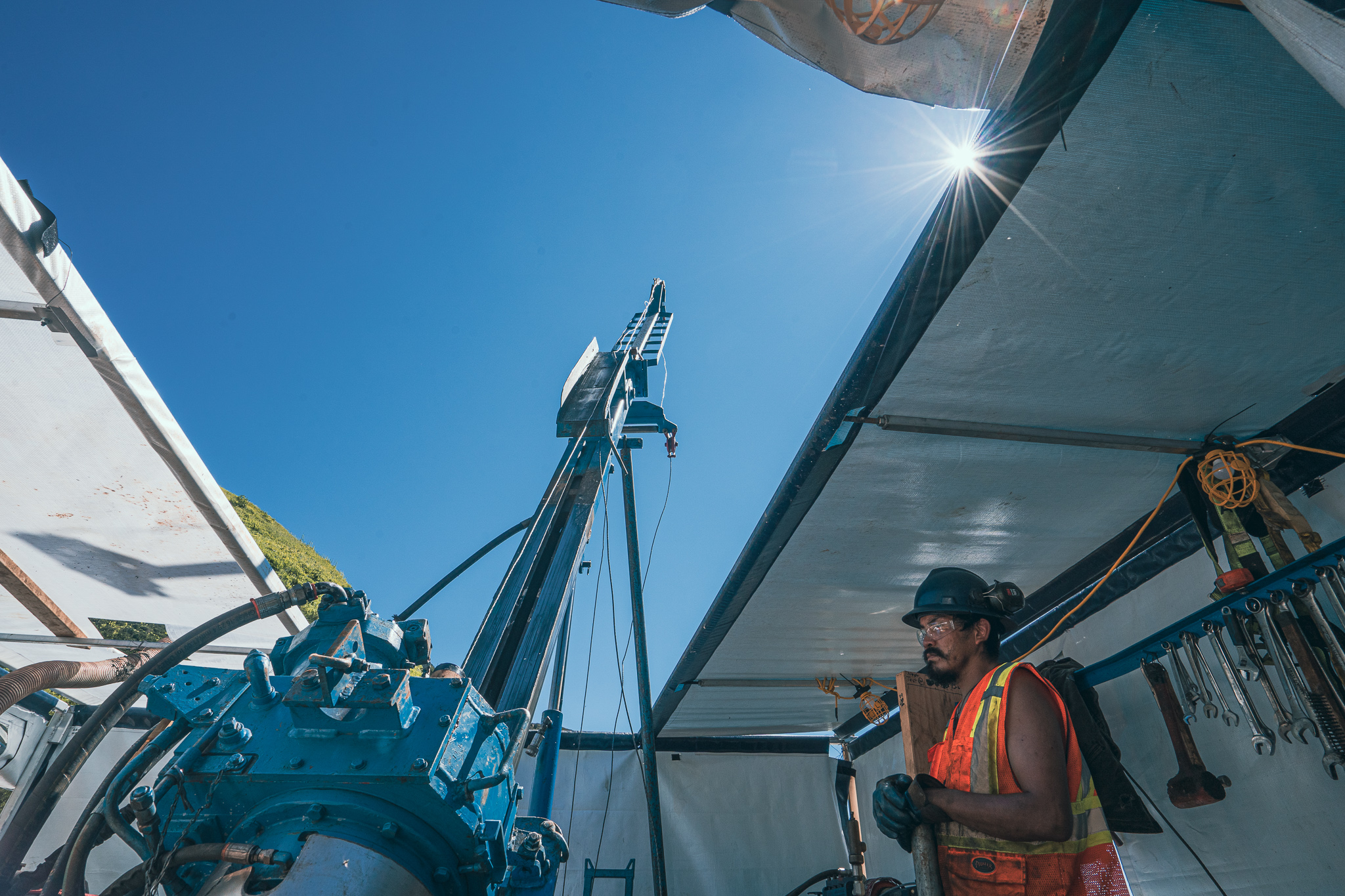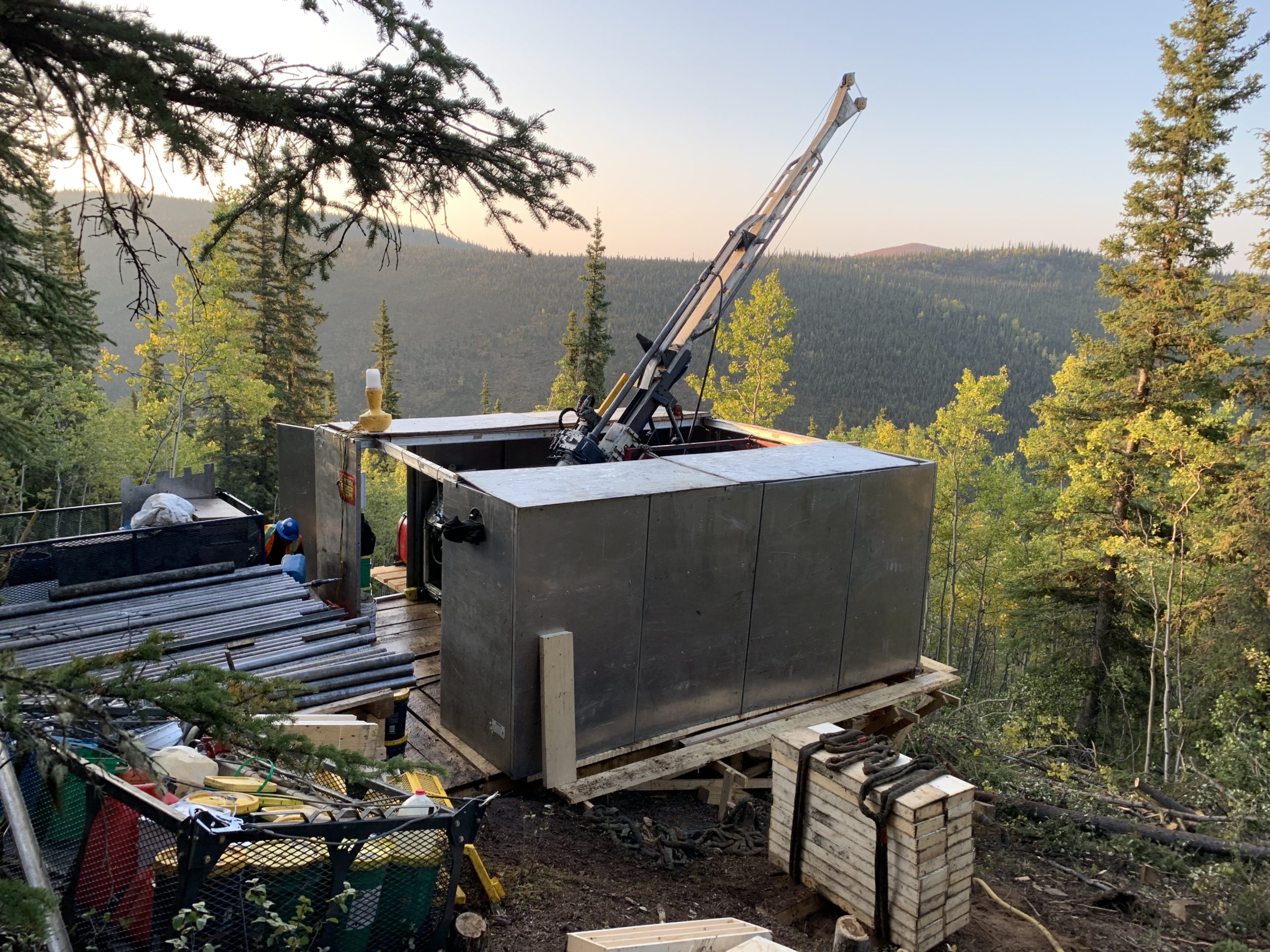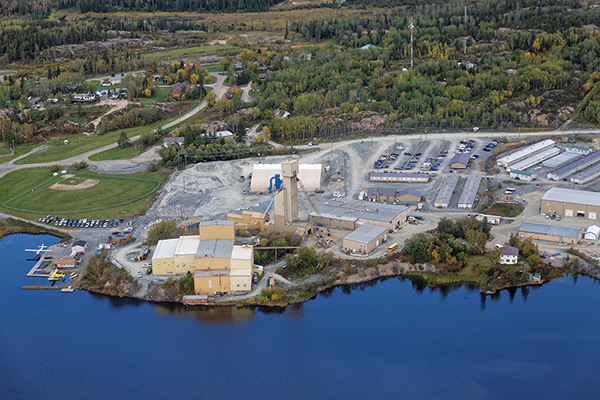Going After Deep Gold
The Red Lake Gold Camp has long been synonymous with bonanza grades. For more than 60 years the Campbell mine provided half-ounce head grades, making it the world’s richest gold mine. The focus has shifted to deeper deposits at the Red Lake (formerly Dickenson) mine that is delivering even better grades.
Developed in the late 1940s, the two properties operated independently before Goldcorp was able to acquire both and rationalize operations. Goldcorp acquired Dickenson Mines in 1994 and Placer Dome’s Campbell mine in 2006. This year, Red Lake Gold Mines (RLGM) is expecting to produce 675,000 oz of gold. At today’s gold prices and a cash cost in the neighbourhood of $300 per ounce, it is one of the most profitable gold mines in the world.
In only four years, RLGM has merged the operations and workforces of both mines, absorbed Dynatec’s contract workers onto the payroll, built a modern fly-in/out camp, launched a home building program in both the Red Lake and Balmertown communities, and applied for and received certification of the International Cyanide Management Code. In May 2010, RLGM poured its 20-millionth oz of gold. The company’s track record is impressive.
Historically the Red Lake camp has produced 27 million oz of gold, 75% of that from properties owned by RLGM. Chris Osiowy, manager of exploration, explained how a gold-bearing corridor can be traced from the Red Lake mine to the Campbell mine and westward to the former Cochenour-Williams, Gold Eagle and McKenzie Island mines.
Today’s geologists are finding gold in places unheard of 60 years ago. Former mines exploited near-surface quartz carbonate veins. Now they are testing mineralized zones associated with a central ultramafic unit that is highly carbonatized and altered. The search has taken them to a depth of 2,500 metres. The Red Lake Complex and Campbell Complex were interconnected by a drift at depth at mid year. Exploration drilling of the High Grade (HG) zone began in earnest and will continue into next year testing it at depth and in an area previously untested. Drill results to date have been excellent.
“There’s lots of potential,” said Osiowy. Enough potential for RLGM to mount a $30-million drilling program. Last year’s program intersected 1.1 metres (true width) of 3,706.9 g/t Au on the 50 level and 34.7 metres of 136.3 g/t on the 47 level.
The Red Lake mine
The Red Lake Gold Mine is accessed via the No.1 shaft to the 23 level, and the new Balmer shaft from surface to the 43 level. The Balmer (No.3) shaft was completed in 2007 as part of the HG zone development. It is equipped with two 13.5-t skips to hoist 1,100 t/d ore including 500 tonnes from the HG zone.
The active mining areas are found between the 30 and 46 levels. The predominant mining method is longhole. Approximately 65% of the ore comes from this method. A further 20% is mined using cut and fill techniques. The final 15% is development ore.
Next year’s mining plan includes some of the old upper Red Lake workings. Anticipated grades are in the 6.9- to 13.7-g/t range.
“There are still some half-ounce stopes up there,” said Peter Gula, assistant underground superintendent.
The HG zone is found between the 30 and 57 (2,500 metre) levels and is still open at depth. It is responsible for breathing new life into the Red Lake mine. But mining of this zone at depth requires a means of de-stressing the area. Over the years, innovative de-stressing mining methods have been developed to mine highly stressed ground at depth, pillars and difficult geometries. As an example, a de-stress curtain of 80,000 tonnes had to be excavated in waste rock to de-stress an area containing more than 200,000 oz of gold. RLGM is continually refining its mining techniques and sequencing to allow safe ore extraction of the deep HG zone mining areas.
Manager of mining, Marc Lauzier said, “Only 20% of the ore comes from the HG zone, but that ore contains 56% of the recoverable gold.”
Mining will eventually reach 2,500 metres or more, and the workings can get very warm. That makes ventilation a challenge. Intake air is pushed into the mine down the shafts, through the older workings (to cool it in the summer) and pulled out through five exhaust raises. The air going down the shafts is heated in the winter to prevent freezing of the shaft infrastructure. The use of ventilation-on-demand is being considered. Electric underground vehicles are currently being used and new technological developments should allow for the expansion of the electric fleet.
The current mining fleet includes small Tamrock and Caterpillar load-haul-dumpers, single-boom jumbos and 17-t trucks. All LHDs are capable of remote control. Larger Caterpillar LHDs, a 30-t Cat truck and a two-boom jumbo are used for ramp development. There are also service vehicles including bolters, shotcrete trucks, scissor lifts and Kubota personnel carriers.
There is no crusher underground. Instead, rock breakers and grizzlies ensure that ore is no more than 300 mm before it is skipped. Jaw and cone crushers on the surface reduce the size to approximately 9 mm ahead of the grinding circuit.
The Campbell mine
The Campbell mine is serviced by a pair of shafts. The Campbell shaft reaches 1,315 metres below surface. The Reid shaft, 150 metres to the west, extends to a depth of 1,820 metres. Approximately 1,850 tonnes of ore is hoisted daily. Although narrow vein and remnant mining is practiced in old sills, the predominant mining method is longhole.
Above 27 level, the mine is equipped with tracked haulage on each level as well as rubber-tired diesel equipment. This equipment is captive. All levels below 27 level are accessed by ramp. Mining is mechanized for greater flexibility and productivity.
The Red Lake mill
The Red Lake mill recovers at least 96% of the gold in the ore from the mine of the same name. It has the advantages of being compact, secure and only 10 years old. The original mill was dismantled and the current one commissioned in 2000 to coincide with the expansion of mining.
Fine ore is reduced to 70% passing 200 mesh in a 3.5 x 5-m ball mill in closed circuit with a cyclone. The cyclone overflow is pumped to a pack of cyclones in closed circuit with a Metso Vertimill that produces a grind of 90% passing 200 mesh. Both the ball mill and Vertimill have Knelson concentrators in line that produce a product that is passed across a gravity table.
Overflow from the secondary cyclones is thickened and leached before the eight-tank carbon-in-pulp circuit. The carbon is loaded to between 8,500 and 10,000 g/t and stripped at intervals when the desired loading is achieved. Gold is recovered from solution in a pair of electrowinning cells operating in series.
Sludge from the electrowinning circuit and concentrate from the gravity table provide feed for the refinery. About 45% of the gold in the ore is recovered by gravity and a further 45% in the CIP circuit.
The refinery smelter and the moulds are enclosed in a large ventilation hood during the pour. This is a precaution to collect and remove any arsenic gas that is created during the melting process. Each pour of 4,000 oz (roughly 215 kg) creates doré bars that are between 800 and 925 fine. The bars are shipped to Johnson Matthey for further refining.
Treatment of the tailings from the CIP circuit involves detoxification using Inco SO2 technology. They are then conditioned and treated in a rougher-scavenger-cleaner flotation circuit. Final tails are drawn from the underflow of the flotation circuit and either placed in the Red Lake tailings pond or used to make paste fill for the mine.
Flotation concentrate is thickened and filtered. It can be either stockpiled or sent directly to the autoclave at the Campbell mill.
The Campbell
mill
The Campbell mill shows its age. Parts of the original building from the late 1940s can be seen. It has expanded over the years, but not in any manner that follows the flowsheet from beginning to end. Nonetheless, it does have an important part to play in producing RLGM gold.
Run-of-mine is reduced to 20 mm in a three-stage crushing circuit consisting of a jaw and two cone crushers. The fine ore passes through an open circuit 2.7 x 3.8-metre rod mill and a 3.8 x 4.7-m ball mill in closed circuit with cyclones to produce a grind of 85% passing 200 mesh. Grinding circuit underflow is pumped to two Knelson concentrators then passed over a shaking table to recover the free gold.
The grinding circuit overflow is pumped to a flotation circuit consisting of roughers, cleaners and scavengers. At this point the flotation concentrate is combined with that from the Red Lake mill, and the resulting stream is treated by pressure oxidation in an autoclave. The 15.25 x 2.7- metre autoclave went operational in 1991 to replace the original roaster circuit. The autoclave product passes through a carbon-in-leach circuit before joining the flotation tailings in the conventional cyanide leaching tanks.
The leached pulp enters the head of a six-tank CIP circuit, followed by a carbon stripping circuit and electrowinning. The stripping vessel is operated once a day, and the gold loading varies from 6,000 to 10,000 g/t. Barren pulp is first detoxified, then thickened and used as paste fill or piped to the tailings management area.
Since the merger, the Campbell refinery has been inactive. All of the shaking table and electrowinning products are sent to the Red Lake mill for smelting. The stripping circuit at Red Lake also has the capacity to handle loaded carbon from Campbell.
Neither mill operates with a lot of high-end technology, explained mill superintendent Ian Glazier. “The autoclave at the Campbell complex has programmable logic control and a distributed control system. There is only a PLC at the Red Lake mill. The operator is the expert.”
Fortunately, RLGM has an experienced and knowledgeable workforce.
The Campbell mill also has what may be a first in the gold mining industry, a hydrogen cyanide detector based on a non-visible laser reflector. Similar equipment is common in the oil and gas industry, but the gold industry typically relies on sniffers to detect HCN gas, as RLGM does in the Red Lake mill.
Environmental success
RLGM operates separate tailings areas at the Campbell and Red Lake complexes, which is the result of operating two mills. Opportunities in the future may allow for these to be combined into a larger, central system.
One of the most rewarding environmental successes at RLGM has been the rehabilitation of Balmer Lake. After decades of tailings deposition and effluent discharge from previous operators, it was declared dead in 1988.
“We committed to cleaning up our effluent, and the 260-hectare lake is now returning to acceptable conditions,” said environment manager Dave Gelderland. “The Balmer Lake watershed has become a viable ecosystem.”
Water treatment through the 1990s cleaned up Balmer Lake enough that 20 walleyes were released into it in 1999 as a test population. They were radio tracked for over a year, and successfully reproduced. A decade later northern pike migrated upstream and have been re-establishing themselves as a top predator in the lake. By 2010 the fish population was dynamic. Balmer Lake is now returning to a healthy and productive ecosystem.
RLGM has also been developing wetland areas that passively remove ammonia, produced by the SO2-air process, from the detoxified tailings effluent and blasting agents. The wetland at the Campbell Complex was created in 1998, and the wetland at the Red Lake Complex has just recently completed.
Reopening the Cochenour mine
Goldcorp has a bright future in the Red Lake Gold Camp. In 2008 it acquired Gold Eagle Mines, which made a new discovery in 2005, the Bruce Channel deposit below the historic Cochenour mine in the town of the same name. The deposit is geologically similar to the Red Lake, Campbell and Cochenour-Williams mine (over 1 million oz of gold from 1939 to 1971).
Production is to begin in 2014, but before that happens, there is much development work to do.
The Cochenour shaft will be enlarged, refurbished and fitted with a new headframe and hoist arrangement. That will be something of an accomplishment at a site only one small city block in size and with residential properties surrounding it.
When CMJ visited at the end of November, the project was two days into the continuous slip forming of a 60-m concrete headframe. The site buzzed with trucks large and small, temporary offices and the busy-ness of development.
The shaft will be approximately 1,065 metres deep and fitted with a cage, two 13-t skips and a counterweight. Development will be carried out on the 2050, 2200, 2600 and 3200 levels. The shallow old workings will be re-explored, and the deeper mineralization tested both from surface and underground. Waste will be hoisted at a rate of 1,050 t/d; however, the shaft has the capacity to hoist 2,000 t/d.
Cochenour residents will be spared the noise and congestion of a full mining, crushing and processing facility. There will be no mill at Cochenour. Instead, work is already underway on a 5-km, 4.25 x 4.90-m high-speed underground haulage drift that will connect on the 54 level with the Red Lake mine. Ore from Bruce Channel will be hoisted up the Reid shaft for treatment at the Campbell mill.
More importantly, this drift will allow exploration over 5 km of untested ground in one of the world’s richest gold districts. The tunnel is in progress and is now over 20% completed. The first of the drilling stations is complete, with considerable drilling planned over the next several years.
With Goldcorp’s hard work in the area, the Red Lake Gold Camp may be producing half-ounce grades well into the future, just as it has for the past 60 years.





Comments